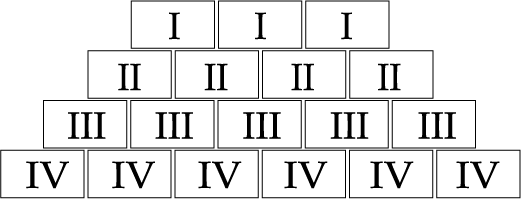

The First War
|
|

|
Speed: A piece may only move to an adjacent tile, i.e. each piece has 1 movement point.
Crossing Lakes: If a piece borders a revealed lake, it may move across the lake to a tile that touches it. If the tile the piece is traveling to is not yet revealed, then handle it as a Discovery. ending in the space in which it started the turn. If the destination turns out to be other than lake, the move is successful. If the destination turns out to be a lake, return the piece to its starting point; it does not move on this turn.
Move one by one: Pieces may move one by one so that perhaps a first piece can discover a lake and the second, third and fourth attempt to cross it.
Stacking: At no time during a turn may a player move so that he has more than 4 of his own pieces in a tile.
Attacks: An attack occurs when a piece enters a tile containing one or more of the other player's pieces. Upon entry, the piece(s) must immediately stop moving, even if more movement points (as a result of Research and Development) are available. Such a move results in Conflict. A wounded piece may never attack.
Attacks across lakes: A piece may not enter a tile by crossing a lake if the tile contains any enemy pieces.
Tallying Strengths: In conflict, pieces have different strengths as follows:
| Piece Type | Attacker Strength | Defender Strength |
|---|---|---|
| Hunter | 2 | 1 |
| Farmer | 1 | 2 |
| Healer | 0 | 0 |
| Scientist | 0 | 0 |
Allocation: In the tile, the defender arranges his pieces into stacks. He may leave each of his pieces in a separate stack or stack them all into a single stack. Then the attacker places his pieces atop the ones he wishes to attack. He must cover as many stacks as he can, even if in some cases his own piece is at a disadvantage.
Triple advantage: Compare the strengths of each stack in conflict. If one side is at least triple that of the other, return the weaker side to their owner's population track.
Simple advantage: If a side is stronger, but not three times as strong, then the weaker side is wounded; placed a white cube on the stack to show this. This stack must retreat.
Tie: If both sides are the same strength, both are wounded; place a white cube on each stack to show this. The attacking stack must retreat.
Attacker Retreats: When an attacking stack retreats, it moves one space to the tile from which it entered the conflict (which may have come across a lake) or to a space containing only its own pieces. Pieces may not retreat into a tile already containing four of one's own pieces. Return pieces having no legal retreat to the owner's population track.
Defender Retreats:
The defender retreats to an adjacent land tile which does not contain
any of the opponent's pieces and from which no attacker came.
A defender may not retreat across a lake.
Pieces may not retreat into a tile already containing four of one's own pieces.
Return pieces having no legal retreat to the owner's population track.
A defender may attempt to retreat to an unrevealed tile. Should this
tile should prove to be a lake, leave it face up, but return the piece(s)
to the owner's population track.
Further Conflict: If after conflict there remain pieces belonging to both sides on a tile (because the attacker could not cover every stack), repeat the attack process with the remaining pieces, as many times times as necessary, until one player's pieces remain.
How much food is available:
Each player calculates this using his own pieces:
Resolution: If the amount of food equals or exceeds the population, there is no difficulty. In addition, each extra 3 food can remove a wounded marker from a Healer piece. But if there is a food shortfall, then the player must place white cubes on a number of his pieces equal to the difference. He may choose any of his pieces, which are now considered wounded. If he places a white cube on a piece which is already wounded, this piece is returned to his population track instead, but he may not do this unless every other of his pieces is already wounded.
Food emergency: A player may, at the start of his turn, declare that for the current turn only, all of his pieces will temporarily act as farmers for food distribution purposes. This declaration affects the rest of the turn as follows:
|
Smelting (7)
Each additional mountain tile occupied by an owned scientist increases the player's research points for the turn. |
Tally research points: In the beginning of this phase the player adds together the following quantities:
Research: At the start of the game, the player may reveal only level I cards. A player reveals a card by spending research points equal to the card's level. When any level I card has been revealed, a player may spend 2 points to reveal a level II card. This in turn permits revealing a level III card, and so on.
Signifier: To signify that a card is active, place a white cube on it.
Points are lost: Any research points not spent in the current turn are lost.